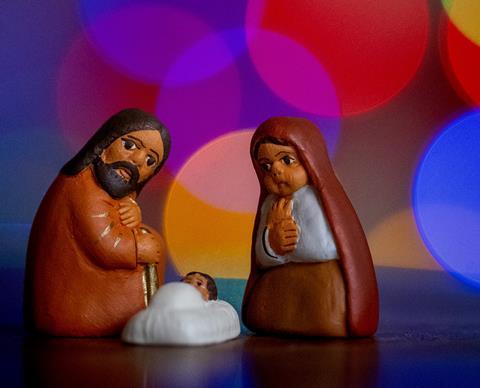John Prockter gets excited about the wonder of Christmas all over again

If you’re anything like me, you might find yourself slightly cringing at the idea of participating in nativity plays and Christmas activities in your school ministry. Over the years, I’ve been every bit the teenager’s youth worker rather than the fun-loving children’s worker.
At home, I’ve always loved the celebrations; the nostalgia and the tradition are really important to me. Regarding youth ministry, I’ve had quite a different perspective, even to the point of avoiding primary school-focused events, working instead to subvert the lip service paid to Jesus, with teenagers who didn’t like the ‘silly’ Christmas activities either.
Instead of Christmas being used to find meaningful opportunities to share Jesus with young people, all I could see was a lot of fuss that ultimately led young people to Santa. Of course, you know as well as I do that Jesus is so much bigger and broader than a baby in a manger, and as I’ve got older, I’ve come to realise that even the most straightforward traditions like cutting and sticking a nativity scene, or playing Mary and Joseph in a nativity can ultimately end up being wonderful opportunities to share Jesus.
In fact, if you read no further, I’d like to encourage you to lean into Christmas in your youth ministry even more than you already do. I’ve got five angles you could use that could help you find meaningful conversations with Children and young people. Think of them as conversation starters or themes to work around.

Jesus is present throughout the Bible
Recently, I was invited into a primary school to teach years 5 & 6 about where we find Jesus in the Bible. They’re keen for me to talk about Jesus being present throughout scripture.
This feels like a wonderful opportunity to open up a conversation about the eternal Jesus. One great example is when Daniel sees a vision of ‘The Son of Man’ who will have an everlasting kingdom. This is mirrored wonderfully by Jesus in Matthew 16, where he calls himself ‘Son of Man. ’Son of Man’ is later repeated a third time in Revelation chapter 1, where he sees a vision of the son of man. This subject might all seem quite heavy, but I think there’s a great conversation here, and you can find far more comprehensive information here.
Of course, there are other wonderful stories of Jesus in the Bible. He’s the word of God at Creation, the ‘I am’ in the burning bush, and the ’The angel of the Lord’ who appears and speaks as God himself.
Genesis 16:7-12; 21:17-18; 22:11-18;
Judges 2:1-4; 5:23; 6:11-24; 13:3-22;
The Advent of God becoming a man
One of my favourite assemblies to do at secondary school is about advent. Advent is such an underrated and very misunderstood season.
When I speak to teenagers, I like to try to explain the extraordinary Advent at Christmas.
In a sense, advent is nothing special; it means “the arrival of a notable person or thing.” What makes advent interesting is that, as a rule, you could only use the term at the beginning of something.
For example, there was the advent of the computer, the car, the smartphone, penicillin and, most recently, AI.
What I find most incredible is that the advent of God becoming a man has become so transformative that we revisit it every year, spending time preparing for the most astonishing thing the world has ever seen. The day when God became a baby and lived among us.

Mary and Joseph weren’t in a rush
I think the nativity story is a wonderful tradition. Still, it does something to the story of Jesus’ birth that I don’t like.
While it’s true that Mary and Joseph didn’t find an easy place to rest, they were actually on a very well-planned journey. They might not have wanted to go, but in the end, they did have to make the journey, and I think it speaks clearly about the level of humility God chose for Jesus.
Santa believes in Jesus
I know, I know… Please stick with me for a moment. We can have a good conversation with young people about Santa and God, especially when some young people are happy to believe that God and Santa are similar.
I can sympathise with the idea that God is a bit like Santa. After all, the original Santa mythology was based on someone who loved God.
The story goes that Bishop Nicholas was from what we know as Turkey today. He lived around 300 years after Jesus and met people’s needs. In one story, he gave bags of gold to a family in debt to save three girls from prostitution. In a more extreme tale, Nicholas, it’s said, raised three young boys back to life who had been brutally murdered. (Probably not a subject for primary school)
If this version of Santa is what we’re talking about, then it isn’t a bad starting point to use for people to access belief in God. Sadly, Saint Nicholas has been lost in time in favour of the Coca-Cola Santa. But if we match the modern Santa up to God, we have a problem. You see, the God of the Bible isn’t stockpiling toys for us all. Instead, although he has good gifts for us, God is far more concerned about relationship.
Santa is, by definition, a magical distraction, and his impact just about makes it to Christmas lunch. On the other hand, God is more interested in our everyday lives, and the impact Jesus makes lasts all year round.
Celebrating someone’s birthday is about what you give
Last but by no means least is this old chestnut. The cliche of cliches. “It’s better to give than to receive,” and of course, it’s correct. Why not focus your youth and children’s ministry on how we give and why that’s one of the most important things to do during the Christmas holiday.
Merry Christmas
John





































